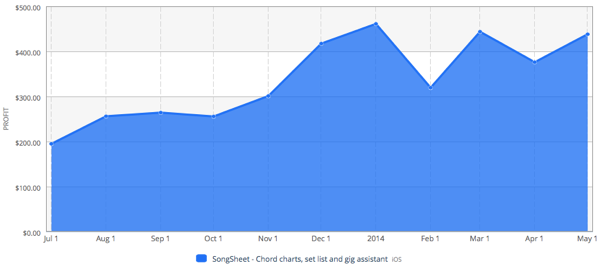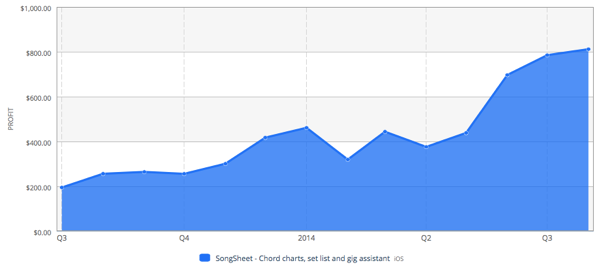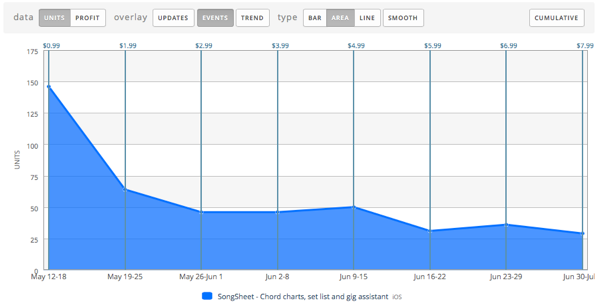I am an Indie iOS Developer - Part 2
This is the second part of my story about becoming an indie iOS developer. Read part one.
##SongSheet or bust
At the time I was deciding to become a full-time indie iOS developer, my financial options looked like this:
- Sell our house, start renting, and develop and publish iOS apps while living off the proceeds of the sale. Continue to try to get freelance development work to top up the budget.
- Borrow enough money to cover 6 months full-time work on building an income through iOS apps.
Scenario #2 is obviously the one I chose. Failure simply brings us back to option #1. Success means not having to go through the hassle of selling and moving. I (and my wife) liked this option more.
The next question was: do I work on new apps, or continue to work exclusively on SongSheet?
My decision making went something like this:
-
I have an established product in SongSheet, with (slowly) growing revenues (I’ll expand on this bit below). I know its market and how it fits in compared to the competition. I know the app’s major deficiencies and what can be done to fix them. I can hit the ground running.
-
I have ideas for completely new apps, but to develop one from scratch is not just a matter of writing code. I have to evaluate my ideas by researching the target markets and competition to try to determine which (if any) of my ideas is the most viable option. It may mean going back to the drawing board and coming up with entirely new ideas. In other words, I’m going to have to crawl before I can walk.
To me, it seemed that working on SongSheet was the lower-risk choice of the two options. In this part I will focus on SongSheet’s revenue - past, present, and a brief outline of future expectations. In future posts I hope to go further into some of my immediate strategies to drive revenue growth and the reasoning behind them.
##A growing revenue stream
“If you want to make “real money” from a paid-up-front app, your launch week has to be a box-office smash.” (Jared Sinclair, A Candid Look at Unread’s First Year)
This was one of Jared Sinclair’s conclusions given the performance of his app, Unread (an RSS reader), on the App store. (I recommend you read his whole post, and his follow-up, Five Hard Lessons Learned from Unread as well).
I’ve come across similar sentiment on other blogs: expect the highest income for your app in that golden launch period, before it begins its drift off into obscurity. You might expect to see bumps in revenue when you release a new version, or if Apple decides to feature you in some market. Other than that, the best is over, and you might as well spend most of your time working on the next app. Then, perhaps, after you’ve got a portfolio of apps on the store, together they might have enough residual income that you can start doing those other things you’ve always dreamed of doing (spending more time with family, going on holidays, writing a book, etc).
While this is likely true for many apps, I do not believe it is a rule. A close look through the top grossing lists on the App Store reveals quite a number of apps that have been around for a long time. These are ongoing, profitable businesses for their publishers. Considering the iOS market has grown as millions and millions more devices are sold, these businesses must also be growing in order to remain in the top lists. Some of these are games, but many are productivity apps, or music apps, and so on. Most of these probably aren’t multi-million dollar businesses, but they do keep individuals and small teams gainfully employed.
I want SongSheet to be one of them.
I mentioned in my last post that SongSheet had a rather disappointing launch week in terms of revenue, and it only went downhill from there. We tried hard to arrest that downhill trend: we released updates with new features; we posted about the app in relevant forums; we contacted bloggers (both main-stream tech blogs and music-focused sites) pitching the app for review; we tried mobile advertising; we tried reducing the price. Occasionally we saw short-term results, but overall the trend was down.
The lowest point came during the week beginning Monday, June 17, 2013, when SongSheet earned a grand total of $36.24 from 10 downloads. However, the worst monthly figure was actually in the following month. July 2013 brought in a grand total of $194.90 in revenue. (I was reluctant to reveal figures in my previous post, but I’m braver now. Also note that all revenue figures I’m giving are in my native currency, the Australian dollar, which is currently worth a hair under US94c.)
When I was deciding what to do during June of this year, SongSheet’s monthly revenue from the low in July 2013 through to the end of May, 2014, looked like this:

Towards the beginning of this period, we released a couple of minor bug fix updates. It was the end of March this year when we finally released our major 2.0 update with iOS 7 support. During this period, we did very little marketing, and the price was stable at US$4.99 for almost the entire time. And yet, revenue at the end of this period had reached a relatively consistent double the revenue of July 2013.
Since it was already well into June when I was making my decision about what to do, I had a pretty good idea that the month was already tracking well ahead of May’s figures. By the time the transaction was completed and I became SongSheet’s sole owner/developer, June’s figures were in. The upward trend had continued. And it has continued since, through July and August. This is what the above graph looks like when brought fully up to date:

Yes, it’s still far from a full-time income. But, the interesting question is, why is revenue growing like this? I wish I had all the answers, but I don’t. I only have (what I hope are reasonable) guesses. SongSheet still hasn’t had a lot of press, certainly not on any major blogs or app news sites. Neither has it ever been featured by Apple. SongSheet’s 2.0 update had no immediate effect on sales, either (although we got a lot of positive comments from customers who had been with us since the 1.x days).
Here are my theories as to why revenue had been increasing in the time up to making my decision. These are the seeds of my confidence in SongSheet’s future:
###1. App Store Optimisations
In April of this year, I began to more seriously research App Store Optimisation (ASO) techniques, with the help of the Sensor Tower website. As a result of my research, I rolled out my first changes to App Store keywords and app title in the 2.0.2 release - the first time any changes had been made to these since SongSheet 1.0 had gone live. I’m pretty certain that the keywords we chose for 1.0 were far from optimal and probably contributed significantly to slow sales. SongSheet probably wasn’t appearing in many searches on the App Store, although I have no way of knowing for sure, since Apple wasn’t providing that kind of data. With the new app title and keywords, as well as a reworked description and set of screenshots, I’m hoping that SongSheet was appearing more often in searches (resulting in a bump in sales). Again, without actual numbers from Apple, I don’t know for sure if the changes I made really had this effect.
As such, I’m really looking forward to the new data that will be available through iTunes Connect later this year, and hope it will go a long way towards answering the above questions. (Actually, knowing that Apple will be improving app store analytics contributed to my decision to take this path: with better information I’m sure I will be able to more predictably make improvements here.)
###2. Raising the price
Another factor that I believe contributed to SongSheet’s improving revenue, and hence my expectations of its future, was my decision to experiment with its price.
The app store has been plagued by a race-to-the-bottom mentality in terms of prices. Many apps are free (with in-app purchases) or priced at 99c. Even quite complex apps can only be a few dollars on the app store, but command much higher prices on Mac or Windows.
We initially launched SongSheet at US$6.99. As sales dropped, we dropped the price to US$4.99 to hopefully kick things along a little. It made no difference, but we left the price there anyway, hoping that eventually it would generate more interest compared to the competition. Dropping the price to US$0.99 or $1.99 for short periods only lost us significantly more money (while sales increased, they didn’t increase nearly enough), so we always put the price back to the US$4.99 mark.
So, finally (and inspired somewhat by Michael Jurewitz’s blog series on app store pricing from last year, particularly Part 3), I decided to try an experiment to see if there was an “ideal” price point for SongSheet. What did SongSheet’s demand curve look like?
In mid May, then, I set up a schedule of price changes in iTunes Connect: initially dropping the price to US$0.99, and then, each week, moving to the next price tier, increasing by $1 each week. The app went as high as US$7.99 before I quit the experiment. (I quit the experiment because with all the changes happening with me taking over SongSheet full time, launching a new website, releasing new versions, etc, the data would no longer be “pure”).
This is what downloads looked like over the period of the experiment:

At $0.99 and $1.99 there is a big jump in the volume of sales, but from $2.99 onwards, you can see that demand falls off in a gentle slope. Increasing the price in this range reduced demand only a little. What effect, then, did this have on overall profit?

At higher price points total profit was significantly higher. It’s hard to tell for certain because week-to-week variations can skew things a little - it would have been better if I’d run at each price point for a longer period - but if you imagine a smoothed curve then the levelling off between $4.99 and $6.99 and subsequent drop at $7.99 suggests that $6.99 may be the current sweet spot for SongSheet’s pricing (for now).
What this also means is that as other factors drive an increased demand for SongSheet, the shape of this curve will change. At that stage I will likely be able to charge higher prices more reflective of the value the app actually offers its users. But I will have to perform that experiment later!
The significance here is profound: I have two variables I am working with that contribute to overall revenue. One is demand and the other is price. The former I only have indirect control over (through improving SongSheet’s feature set and design, App Store optimisations, advertising, etc). The latter I have direct control over.
“All” I need to do in order to reach a long-term sustainable level is generate 20 sales per day at a US$9.99 price point. My minimum goal is actually a little more modest: 13 sales per day at US$9.99 by the end of 2014. That’s not sustainable long-term, but the revenue generated would give me the extra breathing room to get it the rest of the way there. 13 per day. That’s all I need to succeed!
###3. Customer satisfaction and word-of-mouth
The last of the indicators that told me that SongSheet had a future is potentially the most important. As I’ve interacted with customers who have contacted me for support, I’ve learned a few things:
-
Some users bought and road-tested half a dozen competing apps before settling on SongSheet. In other words, despite many glaring omissions in SongSheet’s feature set, it is still compelling enough to win out over other apps! (Of course, I have talked with others who ended up choosing a competing app due to missing functionality, but wished they could be using SongSheet instead. These are potential future SongSheet ambassadors!)
-
Many users indicated that rather than stumbling upon SongSheet on the App Store, they were told about it by a friend. So, SongSheet is good enough that users want to tell others about it.
-
I also know that quite a few use the app in all their gigs - I’ve talked with some who rely on SongSheet five or six nights a week! In other words, the app has high value to its users. This is why it can sustain a higher price.
Yes, I’ve had complaints, many of them quite valid. And I’m listening carefully to those, too, because they are an opportunity to reach a larger user base as I manage to successfully address each issue.
There are other factors, too, but these are the ones that stand most prominent in my reasoning right now (and this post has already gone long enough!).
##Summary
To sum it all up, then, this is what gave me the confidence to choose this path:
- SongSheet’s revenue was steadily increasing
- I had been learning to improve SongSheet’s app store presence
- I knew SongSheet was of real value to many of its users
- Anecdotal evidence strongly suggested that word-of-mouth sales were beginning to make a real difference
I still have quite a lot to do over the next four months in order to have a hope of achieving my goals. I plan to talk about some of my on-going strategy in later blog posts.
###Recommended reading
Jared Sinclair’s posts about his app, Unread:
Tyler Hall’s experience building a business around Mac apps:
Michael Jurewitz’s blog series on app store pricing